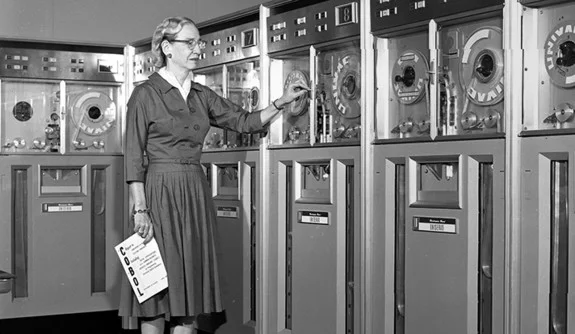Grace Hopper: The "Queen of Code"
Young Grace Hopper 1940s in the National Museum of American History
The mastermind who led the development of programming languages for the first computers - Grace Murray Hopper, an American Naval officer and a pioneering computer scientist, an inspiration for women in coding who helped create the field of computer programming. In this blog, we look into the struggles and success of this inspirational woman - the Queen of computer coding, and how she became a beacon of hope for women worldwide.
Early Life and Education
In New York City, Grace Hopper, born on December 9, 1906, was the first of her parents' three children. Her household valued education and encouraged children to explore their fields of interest. Even as a young child, Grace showed a remarkable curiosity about how things worked and was keenly interested in the mechanism of action and the building of objects. At just seven, she dismantled the alarm clocks in her home and tried to look into their engineering design and process. Grace’s mother supported her passion and pursuit; who herself had a keen interest in and a love for Mathematics. In her early years, Grace was educated privately in New Jersey; later, her curiosity and passion led her to Vassar College, where she graduated with a Bachelor’s in Mathematics and Physics in 1928.
Higher Education and Teaching
Grace’s interest in Maths compelled her to pursue a Master’s degree from Yale University in Mathematics in 1930 and then a PhD in 1934. After completing her Ph.D., she started teaching Mathematics at Vassar College. Grace taught at Vassar College for almost ten years and was promoted to Associate Professor in 1941. In this era, although females faced numerous academic challenges and the idea of women in coding seemed far-fetched, Grace’s determination and Intellectual prowess compelled her to move forward.
World War II and a Transformative Decision
As World War II continued, many women contributed to the war efforts in various capacities and volunteered for different roles. During this period, Grace faced a dilemma between her duty at Vassar College and her desire to contribute to the war efforts directly, so she requested a temporary leave from Vassar College. After her leave was accepted, Grace joined the Women Accepted for Volunteer Emergency Service (WAVES), a U.S. Navy division. She then remained in the Navy, turning down the opportunity to become a full professor at Vassar, and became a Harvard University Fellow under a Naval contract.
A team of computers work at Harvard University (around 1900) to analyze observations and measurements; they were paid less than if they were factory workers. From the Hollis Archives at Harvard Library.
The MARK I Computer and UNIVAC
The original computer bug. Hopper and the Mark II team popularised the terms bug and debugging in computer science (yep, “II”, technology moved on just as quickly back then too). One night the Mark II computer stopped working and, after a painstaking inspection, the crew found a large moth in the electrical relays. They pasted the moth into their log book and from then on they referred to fixing glitches as “debugging”.
During Grace’s period at Harvard, she and her colleagues programmed the Harvard Mark I computer and completed complicated calculations for the U.S. Military. In 1949, she moved to Philadelphia and received the position of senior Mathematician at Eckert-Mauchly Computer Corporation. She soon became a head programmer for the UNIVAC (Universal Automatic Computer), the first all-electronic digital computer, which was then used by NASA’s tracking stations for the Apollo moon missions to communicate with the astronauts.
Programming Computer Language and Beyond
Hopper believed that computers would someday be widely used and helped to make them more user friendly. (Image Courtesy: The Computer History Museum)
In 1952, Grace and her team made a groundbreaking achievement; they developed the first computer language, A-0, also known as the compiler, which translates complex Mathematical codes into machine-readable codes. The compiler laid the foundation for the COBOL language, which became widely used worldwide and allowed people with diverse backgrounds to work more efficiently with computers. Both the U.S. Military and the private sector adopted it.
A Lifetime of Service and Accomplishments
When she retired as a rear admiral at age 79, Hopper was the oldest serving officer in the U.S. Armed Forces. (Image from public domain)
After her initial retirement from the Navy in 1966, she kept serving as a reservist due to her age. Her active service lasted 19 years; she earned the nickname ‘Amazing Grace' by her fellow officers and subordinates for being an inspirational woman. Grace finally retired from the Navy in 1986. To acknowledge her service, she received the Defence Distinguished Service Model. She also received Yale’s Wilbur Lucius Cross Medal. In 1991, President George Bush awarded Grace the National Medal of Technology. Grace was the first female to receive this award and became a renowned name amongst women in coding and various fields. Grace Hopper died the following year on January 1 in Arlington, Virginia, at 85.
Grace Hopper made groundbreaking contributions to computer science. Grace expressed the power of curiosity when she said,
“A ship in port is safe, but that’s not what ships are built for. Sail out to sea and do new things.”
Her life journey proves that with determination, the power of curiosity, and a passion for knowledge, one can make an everlasting impact in any field of work, regardless of gender. She continues to inspire generations of women to pursue careers in STEM and as women in coding and leave a remarkable mark in computer science.





